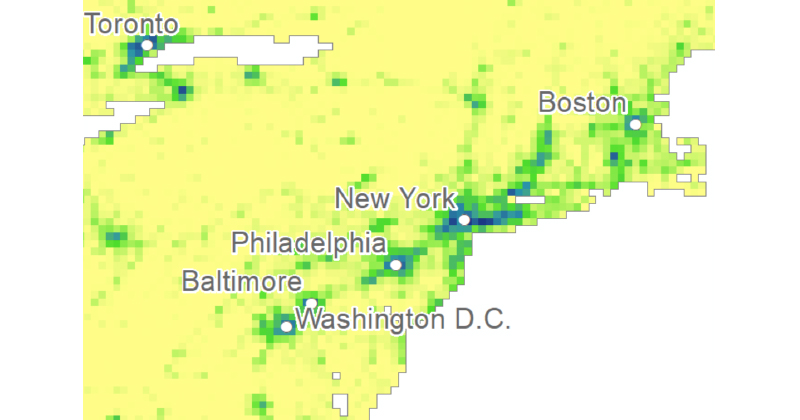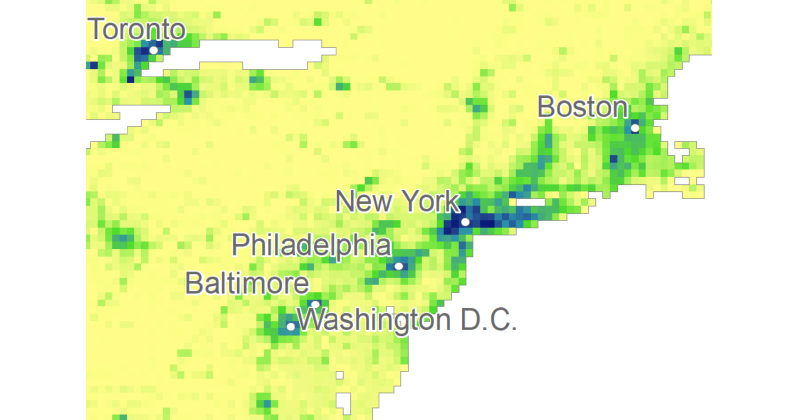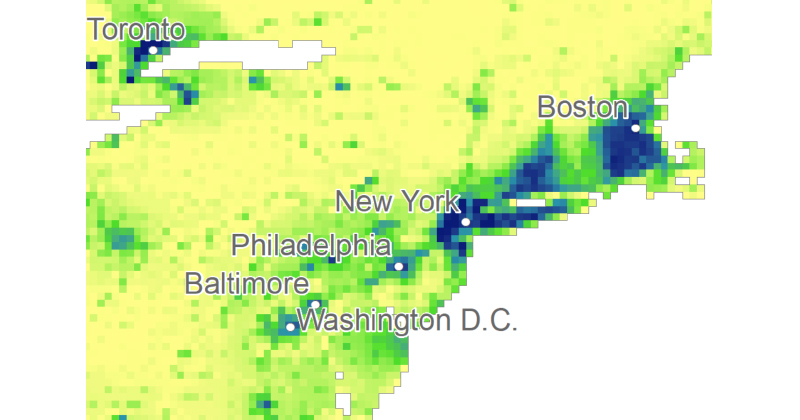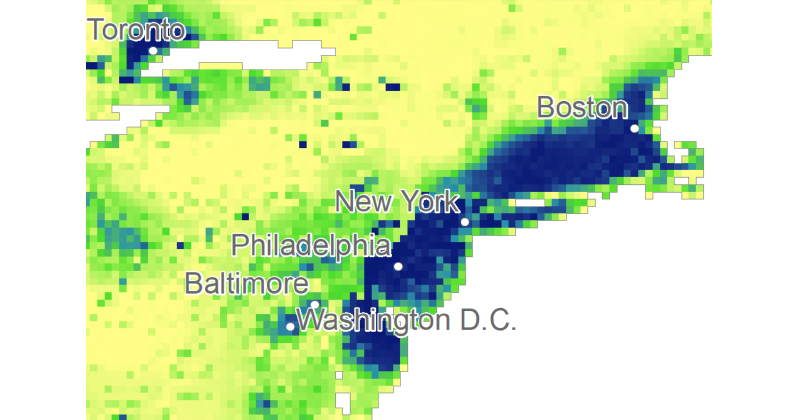

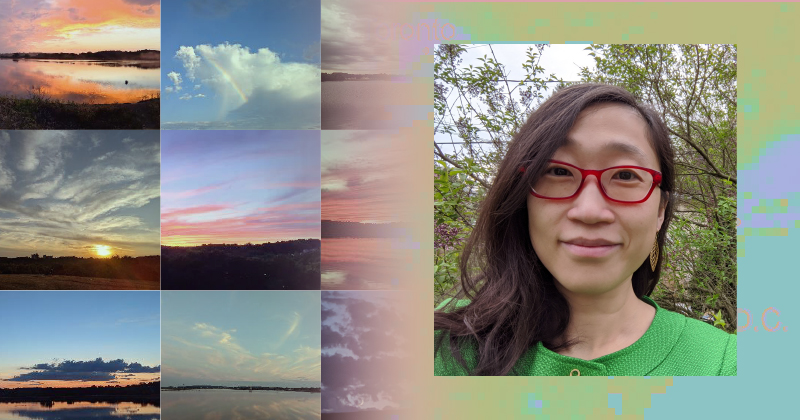
Our cities and climate in 100 years
Photos courtesy of Jing Gao | Photo illustration by Jeffrey C. Chase December 05, 2023
UD’s Jing Gao receives NSF CAREER award to probe future climate and urbanization
As cities grow, they have the potential to make climate extremes, ranging from dangerous heat waves to torrential rainfalls, even worse. And that’s a big concern for all of us. Currently, 83% of the U.S. population lives in urban settings, according to the U.S. Census, and some researchers predict that 97% of Americans will live in urban settings by 2100.
But as Jing Gao, an expert in geospatial data science at the University of Delaware, reminds us, urban developments are designed by us humans and we have the power to change how we plan and build them to live in greater harmony with the environment.
“We can be working now to explore and create urban land systems that moderate — or at least not horribly escalate — negative impacts of 21st century climate extremes on future generations,” Gao said. “As just one example, can we blend urban areas into their regional surroundings in a way that storm clouds with heavy rainfalls would quickly pass through rather than linger over population centers?”
Gao, who is an assistant professor in UD’s College of Earth, Ocean and Environment and a resident faculty member at the University’s Data Science Institute, recently launched a novel research and education project to probe such questions. She is examining the climate resilience of urban areas at large scale — across the continental United States — and over an unprecedented 100 years into the future. Most current studies investigate only individual cities and focus on much shorter time horizons such as 20 years.
Her work is supported by the National Science Foundation’s prestigious Faculty Early Career Development Award, which recognizes faculty early in their careers who have the potential to serve as academic role models in research and education. The NSF award will provide $524,464 toward her project over the next five years.
Using the latest computational techniques and data, Gao will model various interactions between humans and the environment, such as the dynamic between population change and urban land change over time, and how together they interact with changes in climate extremes throughout the 21st century.
The purpose of such “spatiotemporal” modeling is not to predict exactly what will happen far into the future, Gao said, but rather to understand the potential long-term effects of various choices we make today to design urban areas that can optimally cope with and recover from extreme climate events and conditions.
“To enable long-term, large-scale planning for climate resilience, we need a sandbox where we can see how people interact at large scales with the environment and also explore how alternative choices lead to different futures over the long run,” she explained.
A sandbox for increasing our climate resilience
As Gao works in this test environment, she has three key goals. First, she will determine what urban land patterns can moderate human exposure to temperature and precipitation extremes across the U.S. during the next century. Then, using those findings, she will work to design regional urban land systems with long-term, large-scale climate resilience. Finally, she will make the state-of-the-art computer models and new data sets resulting from these efforts Findable, Accessible, Interoperable and Reusable (FAIR) for continued use by other researchers and practitioners.
Working at the intersection of climate change, human dimensions and data science, Gao is on a quest for “transdisciplinary” research that integrates multiple disciplines, as well as leading-edge computational techniques such as machine learning, and to teach her students how to do the same when addressing complex issues and systems involving people and the environment.
Complementing the research, Gao is developing a significant education component to the project — a virtual summer school for undergraduate students nationwide on urbanization and climate change. It will include training in science communication through a collaboration with Paul Brewer, professor in the Department of Communication.
As just one of their activities, Gao said, participating students will interview various experts for a podcast series to be produced in cooperation with the American Geophysical Union’s Sharing Science team.
The National Science Foundation has supported Gao’s transdisciplinary approach to research and education, with three NSF directorates co-sponsoring her project — Social, Behavioral and Economic Sciences (SBE) for Geography, Computer and Information Science and Engineering (CISE) for Computer Science, and Engineering (ENG) for Environmental Engineering.
She has further experience working across disciplines as an author for the Fifth National Climate Assessment and as the inaugural chair of the External Advisory Board for ACCESS (the successor of XSEDE), an NSF program providing U.S. researchers and educators with advanced computing systems and services at no cost.
And while today she is drawn to longer-term futures and how people and the environment interact at large scales, Gao said she wasn’t born thinking that way.
“I started as an undergraduate in geography studying remote sensing. We would spend so much time getting the satellites to take good photos of the Earth, and I was left hungry for what we could do with the photos,” Gao said.
That sparked her decision to pursue a master’s degree focusing on spatial analysis and modeling, and then a Ph.D. in geography with a minor in computer science. Working as a postdoctoral researcher at the National Center for Supercomputing Applications, she gained experience with large-scale computation. Then, as a research scientist at the National Center for Atmospheric Research, she began incorporating socioeconomic and climate modeling. She joined the UD faculty in 2018.
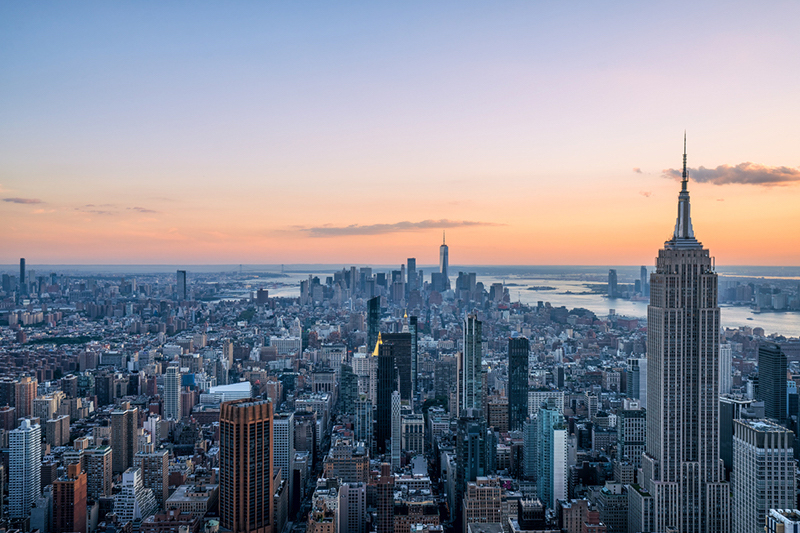
Our urban future
While the United States has two of the world’s current 34 “megacities,” defined as having populations of 10 million people or more (New York City and Los Angeles), many smaller cities, towns and villages in rural areas in the nation are expanding rapidly and have been the biggest contributor to new land developments in the U.S.
Researchers have shown that urbanization can exacerbate some extreme weather effects. For example, hurricanes and storms can get “stuck” in cities, potentially increasing rainfalls and fueling floods.
Meanwhile, Gao’s latest research shows that urban land patterns can sometimes reduce rather than increase our exposure to climate extremes, offering further evidence that we can moderate future experiences with large climate disasters by better designing our urban areas, starting today.
Ultimately, Gao wants her work to provide actionable science and useful tools for testing various measures that will boost the climate resilience of places where we will live, and our descendants will live, in the future.
“Climate change and urbanization are both incremental processes whose effects accumulate over time and across space, similar to when a person develops a disease from long-term habits,” Gao said. “Then a successful cure will require both immediate treatments and long-term commitments to better habits, and lasting urban climate resilience demands enduring transformations of how we interact with the environment.”
Gao is a successful participant of the UD Research Office’s NSF CAREER Academy. The program includes a variety of resources, from mentoring to grant editing, to assist faculty in their pursuit to become NSF CAREER researchers.
Contact Us
Have a UDaily story idea?
Contact us at ocm@udel.edu
Members of the press
Contact us at 302-831-NEWS or visit the Media Relations website

